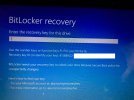Appletax
Well-Known Member
- Reaction score
- 396
- Location
- Northern Michigan
Had a client in the past with a Windows 10 Home laptop. BitLocker was on without them knowing it. It needed the recovery key. They got lucky in that they found it in their Microsoft account.
Got a client today that has a Windows 10 Home laptop with the same issue. Says it needs the key because there was an unexpected change in the Secure Boot policy.
I think it may have been caused by Windows Update installing a BIOS update. Doubt the user went into the BIOS and messed with settings.
Sound right?
What is up with BitLocker being on a Windows Home device without the user's knowledge? So strange!
Windows Home does not include BitLocker, although it does include device encryption (confusing!!)
Is "device encryption" less secure than BitLocker?

Got a client today that has a Windows 10 Home laptop with the same issue. Says it needs the key because there was an unexpected change in the Secure Boot policy.
I think it may have been caused by Windows Update installing a BIOS update. Doubt the user went into the BIOS and messed with settings.
Sound right?
What is up with BitLocker being on a Windows Home device without the user's knowledge? So strange!
Windows Home does not include BitLocker, although it does include device encryption (confusing!!)
Is "device encryption" less secure than BitLocker?



